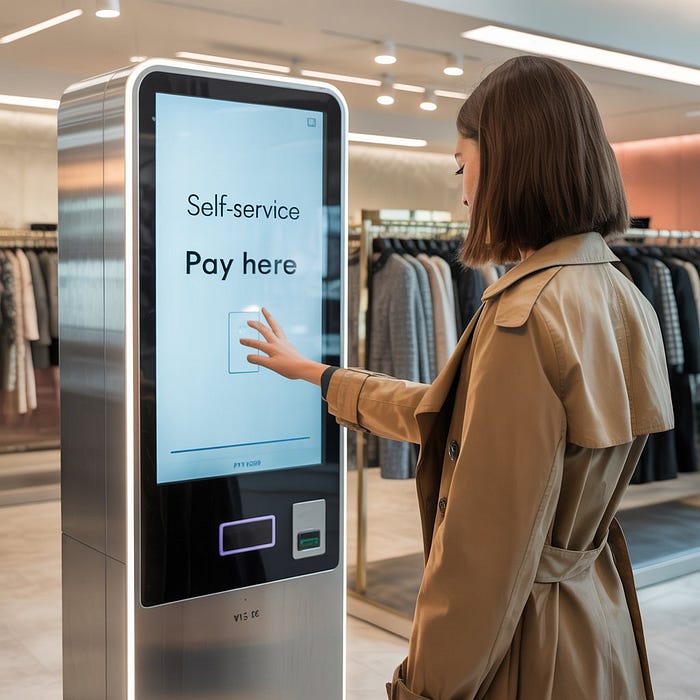Future trends in self-service payment technology.

In today’s fast-paced digital economy, self-service payment technology has become a cornerstone of efficiency and convenience in retail and service sectors. With growing consumer expectations and evolving technologies, staying ahead of future trends in this field is critical for businesses striving to remain competitive. This blog explores the major innovations, consumer behavior, challenges, and future opportunities in the self-service payment landscape.
Advancements in Payment Methods
Contactless and Mobile Payments Expansion
- NFC (Near Field Communication) technology adoption is skyrocketing in retail.
- QR code-based payments are becoming popular in developing markets.
- Mobile wallets (Apple Pay, Google Pay, Samsung Pay) are gaining mainstream acceptance.
- Benefits include faster transactions, enhanced hygiene (touchless), and improved customer experience.
- Merchants are increasingly integrating these systems to boost throughput and customer satisfaction.
Biometric Authentication Integration
- Fingerprint scanning is already popular in smartphone-based payments.
- Facial recognition is being adopted at kiosks and in banking ATMs.
- Voice recognition is emerging in customer service payment systems.
- Enhances security by reducing the risk of unauthorized transactions.
- Increases convenience by eliminating the need to remember PINs or passwords.
Cryptocurrency and Blockchain Adoption
- Bitcoin, Ethereum, and other cryptocurrencies are being accepted by forward-thinking retailers.
- Blockchain offers decentralized verification for secure transactions.
- Benefits include reduced transaction fees, transparency, and increased privacy.
- Challenges include regulatory uncertainty and volatility in crypto values.
Technological Innovations Driving Self-Service Payment Systems
Artificial Intelligence and Machine Learning in Payment Systems
- AI is used for real-time fraud detection through behavioral analysis.
- ML algorithms offer personalized checkout experiences (e.g., targeted upselling).
- AI-driven chatbots assist customers in resolving payment issues quickly.
- Automates routine transactions and reduces need for human intervention.
Internet of Things (IoT) and Smart Devices
- IoT-enabled kiosks communicate with customer devices for seamless payments.
- Smart vending machines detect inventory and process payments autonomously.
- Data collection allows businesses to optimize operations and personalize offers.
- Enhances scalability and reach of self-service ecosystems.
5G Connectivity Enhancements
- Provides ultra-fast data transmission for real-time payments.
- Supports greater device density, essential for smart city infrastructures.
- Enhances reliability and minimizes downtime of self-service terminals.
- Enables remote troubleshooting and system updates.
Consumer Behavior and Market Trends Influencing Self-Service Payments
Demand for Faster and More Convenient Payments
- Consumers expect minimal friction during checkout.
- Preference for contactless and automated solutions is growing.
- Influences design and functionality of kiosks, ATMs, and mobile POS systems.
- Businesses are optimizing layouts for faster flow and shorter queues.
Increased Focus on Privacy and Data Security
- Rising concerns about personal data misuse and cyber threats.
- Encouraging the adoption of end-to-end encryption and tokenization.
- Consumers trust platforms that offer transparency and data control.
- Compliance with global standards (e.g., GDPR, PCI DSS) is becoming mandatory.
Shift Toward Omnichannel and Integrated Payment Experiences
- Integration of online, in-store, and mobile channels is key.
- Unified payment platforms allow consumers to switch between devices easily.
- Consistent experience across all touchpoints drives loyalty.
- Retailers are investing in APIs and middleware to bridge systems.

Challenges and Considerations for Implementing Future Self-Service Payment Technologies
Security Risks and Fraud Prevention
- Sophisticated cyberattacks target payment data.
- Multi-factor authentication and biometric security are becoming essential.
- AI tools must evolve constantly to stay ahead of fraud tactics.
- Real-time monitoring and alert systems are critical for risk mitigation.
Infrastructure and Cost Barriers
- Initial investment in kiosks, POS upgrades, and network infrastructure is high.
- Maintenance and regular updates require ongoing costs.
- Small businesses may struggle to afford advanced self-service technologies.
- Cloud-based and SaaS models offer cost-effective alternatives.
Regulatory Compliance and Legal Issues
- Varying regulations across regions can complicate implementation.
- Data residency laws affect cloud-based payment solutions.
- Businesses must ensure ADA compliance in kiosk design.
- Staying updated with financial regulations is a constant requirement.
Future Outlook and Opportunities in Self-Service Payment Technology
Emergence of Fully Autonomous Payment Systems
- Amazon Go-style stores enable cashier-less shopping experiences.
- RFID and computer vision detect items and charge customers automatically.
- Reduces labor costs and enhances convenience.
- Expanding into restaurants, transport hubs, and entertainment venues.
Integration of Augmented Reality (AR) and Virtual Reality (VR) Payments
- AR mirrors allow virtual try-ons and payments within the interface.
- VR platforms enable immersive shopping with built-in payment options.
- Offers unique branding and engagement opportunities.
- Still emerging, but holds promise for high-end retail and experiential commerce.
Sustainability and Eco-Friendly Payment Solutions
- Digital receipts reduce paper waste.
- Energy-efficient kiosks lower carbon footprints.
- Emphasis on recyclable and sustainable hardware.
- Payment platforms supporting carbon tracking gain popularity among eco-conscious consumers.
Conclusion
The future of self-service payment technology is being shaped by innovation, security, and changing consumer expectations. From AI and IoT to AR and cryptocurrency, emerging technologies are revolutionizing how businesses process payments. While challenges like cost, security, and compliance remain, the opportunities for streamlined, secure, and engaging customer experiences are immense. Businesses that embrace these trends will be better positioned to thrive in an increasingly digital-first economy.
Comments
Post a Comment